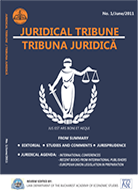Independent bodies as a model of organization of the public administration
Independent bodies as a model of organization of the public administration
Author(s): Borče Davitkovski, Ana Pavlovska-Daneva, Ivana Shumanovska-Spasovska, Elena DavitkovskaSubject(s): Law, Constitution, Jurisprudence
Published by: Societatea de Stiinte Juridice si Administrative
Keywords: independent organs; regulatory bodies; agencies; public administration; separation of powers;
Summary/Abstract: We live in a time when the number of regulatory bodies or independent agencies or so-called parastatal organs is continually growing and gaining momentum as a part of a country’s system of governance. In particular, in the Republic of Macedonia, in the period from 2002, around 24 independent organs have been established with the legislation, which shows that this is not only an actual topic for research and writing but also that there is an actual need for an in-depth study for the purpose of establishing these organs. Simply put, is their establishment in the legal system a necessity or a trend. Hence, the subjects of research in this paper are the reasons or the factors that contribute to the formation of the independent organs, their position in the system of government organization and the distinction between the independent state organs, the regulatory bodies and the independent organs of the state administration. Taking into consideration the fact that through the formation of these organs a new model of exercising public authorization has been developed, a question whether these organs are a new model of organization of the public administration is being raised. A model that enables the decentralisation of certain competencies for which have been the state administration concern so far, and for which the state administration now becomes only an execution controller. All this in order to enable a more efficient, more qualified and depoliticised execution of the public interest services. To achieve the aim of the research in the paper we used historical method, comparative method and normative method.
Journal: Tribuna Juridică
- Issue Year: 8/2018
- Issue No: 16
- Page Range: 453-476
- Page Count: 24
- Language: English

